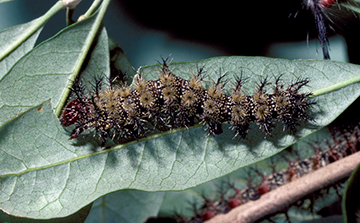
Lafourche Parish Sheriff’s Office Deputy Died After Suspect Rams Vehicle
April 2, 2023
Over 200 Nicholls Nursing Students Receive White Coats at Inaugural Ceremony
April 2, 2023Larvae of the buck moth caterpillar (Hemileuca maia) are large dark caterpillars between 2 and 2.4 inches in length (5.25–6.0 cm). They have reddish heads and small round white spots over their bodies. This species is distributed from Maine to Florida and as far west as east Texas. Buck moth caterpillars tend to cluster on branches and move one behind another when small. The buck moth caterpillar prefers oak (Quercus spp.) trees but has been collected on willow trees (Salix spp.), wild cherry trees (Prunus serotina), and rose bushes (Rosa spp.) along with several other deciduous plant species.
Sting Reactions
The spines found on the caterpillars are associated with venom glands that occur within the caterpillar’s body. When stung, pain is immediate, with radiation to local lymphatic groups followed by localized itching, swelling and redness. Welts raised on the skin can remain visible for 24 hours to a week after a sting. Allergies to these stings have been documented, and people stung should be watched for any potential anaphylactic reactions. Localized contact dermatitis should subside between four to eight hours after being stung.

Buck moth caterpillar on hand, with characteristic contact dermatitis lesions visible below insect. T.D. Schowalter, D.R. Ring, Journal of Integrated Pest Management, Volume 8, Issue 1.

Adult buck moth caterpillar. Gerald J. Lenhard, Louisiana State University, Bugwood.org.
Care of Stings
Pain after contact can last over 24 hours. Antihistamines should be taken with a cold compress applied to help with the pain. Remove urticating hairs and leftover spines using adhesive tape. Wash stung area with soap and water or a sterilizing agent and allow to air dry. If you suspect an allergic reaction, or if the stung regions are clearly swollen, see a doctor for appropriate medical attention.
Seasonality and Control
A single generation of buck moths occurs each year. The caterpillars are abundant between April and May and pupate from late April to June. Buck moths can remain in their pupa stage for up to two years. Adults fly and mate during warm days in November and December. They do not feed after mating. Females lay eggs that overwinter on host plants and hatch when growth appears in early spring. Major infestations are common in urban areas.
Contact the LSU AgCenter and your parish agent for information on chemical control.







